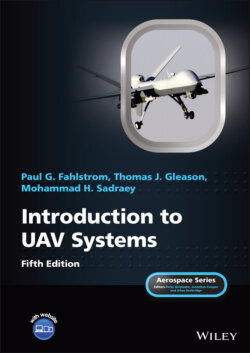Читать книгу Introduction to UAV Systems - Mohammad H. Sadraey - Страница 74
3.7 The Real Wing and Airplane
ОглавлениеA real three‐dimensional conventional aircraft normally is mainly composed of a wing, a fuselage, and a tail. The wing geometry has a shape, looking at it from the top, called the planform. It often has twist, sweepback, and dihedral (angle with the horizontal looking at it from the front) and is composed of two‐dimensional airfoil sections. The details of how to convert from the “infinite wing” coefficients to the coefficients of a real wing or of an entire aircraft is beyond the scope of this book, but the following discussion offers some insight into the things that must be considered in that conversion.
A full analysis for lift and drag must consider not only the contribution of the wing but also by the tail and fuselage and must account for varying airfoil cross‐section characteristics and twist along the span. Determining the three‐dimensional moment coefficient also is a complex procedure that must take into account the contributions from all parts of the aircraft.
A crude estimate (given without proof) of the three‐dimensional wing lift coefficient, indicated by an uppercase subscript (CL), in terms of the “infinite wing” lift coefficient is
(3.7)
where Cl is also the two‐dimensional airfoil lift coefficient. From this point onward, we will use uppercase subscripts, and assume that we are using coefficients that apply to the 3d wing and aircraft.
